THE SOUTHERN CIRCLE AT AVEBURY, INNERMOST RING.
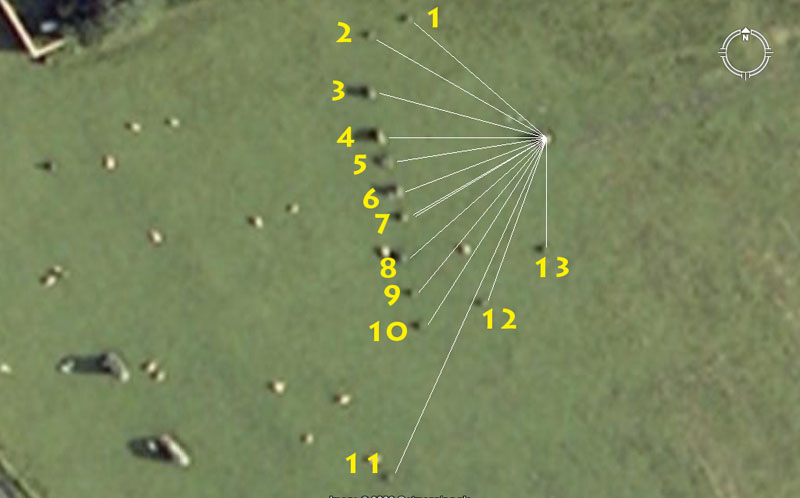
Lines run out from the centre position of the former
obelisk to the first outer set of stones. Each line seen is set to a coded
distance and angle, based upon values that were used universally by the ancient
Caucasoid nations living around the Mediterranean or Europe, etc., demonstrably
5000 + years ago and much earlier. As we progress it will
be seen that the same length and angle standards were used on the Giza Plateau
of Egypt and at the Octagon of Newark Ohio, USA, etc., etc.
Practicality of use would dictate that the centre of
the giant obelisk was the starting position and that the coded length would
run to the face or sides of the outlying stones. One would deduct half the
thickness of the centre obelisk to achieve the encoded number sought after.
The outer marker stones would also be multi-coded in terms of lengths and
angles running to them. The tutor would have known all of the close proximity
mathematical codes inherent in each outer marker position and tutorials would
have relied heavily on the in-depth knowledge of the tutor, with the stone
markers acting as mnemonic devices or triggers for the recall of precise numerical
values.
As we proceed some ancient Weights, Measures and Volumes
standards will be interspersed throughout the text to show that the values
used at Avebury Henge were repeatedly and universally used by other cousin
nations in the millenniums to follow.
STONE POSITION 1
The distance is 601/2'
(60.50'), also
interpreted as 6012/25'
(based upon the full value 6048)
at an angle of 3112/5
° around from North (based
upon the full value 31104).
| JERUSALEM LIQUID VOLUMES (decimal fractions). |
JERUSALEM LIQUID VOLUMES (standard fractions) |
| |
|
| 1 Cor…….18662.4 cubic inches equals
|
1 Cor…….186622/5
cubic inches equals |
| 10 Bath….1866.24 cubic inches, or |
10 Bath….18666/25
cubic inches, or |
| 60 Hin……311.04
cubic inches, or |
60 Hin……3111/25
cubic inches, or |
| 180 Cab….103.68 cubic inches, or |
180 Cab….10317/25
cubic inches, or |
| 720 Log….25.92 cubic inches. |
20 Log….2523/25
cubic inches. |
The distance teaches students about the equatorial size of the
Earth, based upon two geodetic systems built into the base length of the Great
Pyramid (Egypt was a former homeland of European nations before it got too
arid, causing a mass exodus out of Egypt to Europe by about 5000 BC).
The two navigational systems being taught in this length are:
(a). The length of the Great Pyramid (an ancient
Bureau of Standards) was 756' per side.
Two full circumnavigations of the Great Pyramid (8-side lengths) was 6048'.
This distance was 1-minute of arc for a world with an equatorial circumference
of 12 X 12 X 12 X 12 X 1/10th of 12 (so-called
Greek) miles of 5250' each (or 5000 Greek feet @ 123/5-inches
each). This system was based upon a "6&7"
combination of numbers (divisible by either 6 or 7).
(b). If the Great Pyramid was elongated by
a mere 3-inches (by a mark on the paving stones) to be 7561/4-inches,
then two full circumnavigations would be 6050'
for 1-minute of equatorial arc. This would mean that the world
circumference could be read and calculated in an "11"
family of numbers. Thus, under this second navigation and positional plotting
system the world was factored to be 24750 British (so-called) standard miles
(of 5280' each) in circumference. See: Footnote1.
The angle from the centre obelisk to this stone is (& was
read and interpreted as) 3111/25
° In a world that is 12 X 12 X 12 X 12 X 1/10th
of 12-miles in circumference (either Greek or British miles ... 248831/10-miles)
the sum of 3111/25-miles
would be 1/80th of the circumference.
STONE POSITION
2
The distance is 671/5'
(based upon the whole number 672)
and the angle is 300°
The value 671/5
was very important to navigation and this distance at Avebury was 1/90th of
1-minute of the Earth's equatorial circumference, based upon the literal standard
encoded into the Great Pyramid's base dimensions.
ALEXANDRIAN WEIGHT.
1 Talent…….403200.0 grains
equals:
60 Mina…….6720.0 grains, or
80 Libra…….5040.0 grains, or
960 Uncia…..420 grains.
The angle code could be read as either 300°
(5/6ths of 360°)
or, 180° opposed (reciprocal bearing) as 120°
(1/3rd of 360°).
The so-called Babylonian-Sumerian 360° system
was, obviously, well and truly established and in use at Avebury Henge in
the 4th millennium BC., when the Sumerian civilisation was supposedly just
emerging.
STONE POSITION 3
The coded distance is 59.0625'
(591/16) and the return angle is 105°
around from North.
| TRIDRACHM (BEQA) SYSTEM (decimal fractions). |
TRIDRACHM (BEQA) SYSTEM (fractions). |
| |
|
| 1 Talent………590625
grains, equals: |
1 Talent………590625
grains, equals: |
| 60 Mina…….. @ 9843.75 grains, or |
60 Mina…….. @ 98433/4
grains, or |
| 3000 Tridrachm.. @ 196.875 grains. |
3000 Tridrachm.. @ 1967/8grains. |
The value, 59.0625 (591/16)
is lunar coding and is fully built into the geometric dimensions of the Khafre
Pyramid of Egypt. See Footnote1.
STONE POSITION 4
The distance is 54'
and the angle is 270° - 90° return
(due West-East).
The value 54 was highly important to lunar calculations especially.
For example, the 6804-day lunar
nutation cycle is 54 periods of 126-days. It will be remembered that the "Greek"
foot is 12.6 - 123/5-inches. Likewise, the
7.2 - 71/5 lunar year count monitored in
the ancient Sabbatical lunisolar calendar was 2551.5 - 25511/2
days or 47.25 - 471/4 periods of 54-days.
It will be remembered that the height of the Khafre Pyramid under its 3,4,5
triangle design was 472.5 - 4721/2
feet and that the length of the Great Pyramid @ 756'
= 47.25' X 16. By consequence the length of the Khafre Pyramid was 47.25'
X 15. This 54' length at Avebury would be 1/14th
of the length of the Great Pyramid.
This due East-West angle at Avebury is self explanatory and
it would have aided students to set up their manual theodolites or alidade
sighting rules onto a primary point of the compass for taking secondary shots
onto targets ranging throughout the 360° of vista.
STONE POSITION 5
This length was 51.84 - 5121/25'
(intended code) and the return angle is 81°.
| GREEK VOLUMES…DRY (decimal
fractions). |
GREEK VOLUMES…DRY (fractions).
|
| |
|
| 1 Medimnus…3110.40 cubic inches, equals: |
1 Medimnus…31102/5
cubic inches, equals: |
| 6 Hecteus…518.40
cubic inches, or |
6 Hecteus…5182/5
cubic inches, or |
| 48 Choenix…64.80 cubic inches, or |
48 Choenix…644/5
cubic inches, or |
| 192 Coytle…16.20 cubic inches, or |
192 Coytle…161/5
cubic inches, or |
| 1152 Cyathus…2.70 cubic inches. |
1152 Cyathus…27/10
cubic inches. |
The Great Pyramid had a side slope angle intended to be 51.84
- 5121/25° The tutorial built into this
position at Avebury (both in distance and angle) was designed to teach a principle
related to the PHI ratio (1.6180339
to 1) and also "rounded PHI
" (1.62 - 131/50) which is integral
to the ancient measurement systems. See Footnote
2.
Three other points are worthy of mention: The ancient British
League of 3.125 - 31/8 miles (16500'), when
converted from a diameter to a circle using PI @ 3.141818182
(3142/11 ÷ 100) = 51840
feet. This principle was very important to navigation at sea
and was built into the base dimensions of Silbury Hill in one cross measure,
as well as into the the stone lined avenue leading from the henge to the Sanctuary
circle. Alternatively, the 162 value was highly important to lunar counts
and calculations. For example the 6804-day lunar cycle is 162 periods of 42-days.
One of the Station Stones at Stonehenge sits at 162°
azimuth to its opposite Station Stone at 342°.
This length at Avebury would also have been interpreted to mean
52' and relate to the 52-weeks of the calendar year. A tutorial about
the merits of 52.5' (100th of a Greek mile) would also have been taught.
STONE POSITION 6
Again, the stone is expressing triple coded values ranging
from 51.84 - 5121/25'
(navigation) to 52' (calendar)
and 52.5 - 521/2'
(Greek mile). If read as 52.5', then the distance would be 5 Hebrew Reeds.
A hugely important tutorial would have focused on the value 5.25 (51/4th)
as lunar calculations, as well as many navigational calculations, were based
upon this increment.
The return angle was 69.12°
(693/25ths). The sum of 69.12-miles represented
1° of equatorial arc for a world that was 12 X 12 X 12 X 12 X 1.2 miles
in circumference. Under one of the several highly factorable systems, those
miles were considered to be 5280' each ("11" number family)
for a shortfall on the true circumference of only 18.8 - 184/5
miles.
STONE POSITION 7
The distance is 52.8 - 524/5',
providing a tutorial for navigation by the British standard mile, a very popular
option that worked exceptionally well for positional plotting on the vast
featureless oceans. The angle is 240 degrees, for a return angle of 60°.
This feature would relate to tutorials in the sexagesimal chronology system
of 24-hours in a day, reducing to minutes and seconds. It would also relate
to the 360° compass, reducing by minutes and seconds of arc.
On another part of the stone the distance would have, undoubtedly,
represented 52.5' for tutorials related to the Greek mile and lunar calculations.
In this regard the return angle would have been read as 59.0625 (591/16th),
which, in days, represented two lunar months.
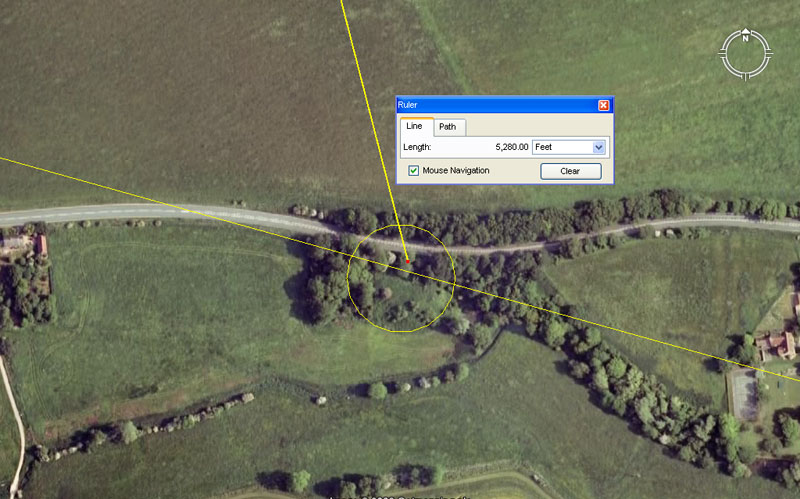
A very large mound, shaped like Silbury Hill was built
on a line between the centre hubstone of the Sanctuary Circle and the crown
of Silbury Hill. This mound has been affectionately dubbed "Silbaby",
because it looks like a miniature version of Silbury Hill. Amongst other coded
assignments, its crown sits precisely 1-mile (5280') from the giant obelisk
at Avebury Henge on an azimuth angle of 345.6 - 3453/5°
back from "Silbaby" to the henge position. It's crown also sits
3888' (Earth equatorial circumference code) from the centre hub of the Sanctuary
Circle at the end of West Kennet Avenue, on an azimuth angle back to the Sanctuary
of 105.6 - 1053/5° (52.8 X 2).
The large size of this mound, which is second only to Silbury
Hill itself, tells us that its in-built coding of position was highly important
to the ancient society that expended so much effort to put it there. One could
postulate that the in-built codes of position were pre-eminent over many other
lesser mound codes around the district and needed to be accentuated by a more
grandiose structure. Here are the dynamic tutorials built into Silbaby's position:
STONE POSITION 8
This distance was coded to be 62.208
- 6226/125' and the tutorial
would have focused on the equatorial circumference on the Earth. One quarter
part of the 24883.2-mile circumference is 6220.8-miles.
The return angle is 48.6 - 483/5°
and this both a strong navigational code and lunar code simultaneously. The
ancient lunisolar Druidic "Calendar of Coligny"
brass plaque, located in France in the late 19th century, was 4.86' in
length. The sum of 486 X 5.25-days was the duration of the 2551.5-day lunar
count (7.2-lunar years) for the ancient Sabbatical Calendar. The sunrise position
at Stonehenge on the day of the Summer Solstice is very close to 48.6°,
etc.
Any and all of the values mentioned herein needed to be put
into mathematical progressions and learned by rote and repetition by the students
memorising the inbuilt tutorials at this open air university. The carefully
encoded numbers were highly scientific and applied to calculations related
to the size of the Earth, lunar cycles, the calendar, world navigation on
the vast (often featureless) oceans or the concept of functioning and abundant
"civilisation".
STONE POSITION 9
This distance is 68.75 - 683/4'
and the return angle is 39.6 - 393/5°
around from North.
In both distance and angle tutorials related to the size of
the Earth were being given. The 68.75' relates
to 1° of equatorial arc according to the Great Pyramid's second geodetic
system that accentuated the "11" family of numbers. In a world that
was factored to be 24750-miles (of 5280' each), 1° of arc was 68.75-miles.
The position would also have homed in on 1° of arc for other equatorial
systems, including 68.727272
(688/11ths) or
69.12 (693/25ths). The angle
code relates to the diameter of the Earth at 7920-miles
of which 3960 miles would be
the radius.
STONE POSITION 10
The distance is 75.6 - 753/5'
and the return angle is 32.4 - 322/5°.
The distance is, of course, related to the length of the Great
Pyramid @ 756' or 8th of
1-minute of equatorial arc.If we consider the length of the Great Pyramid
in inches, then that equates to 9072 (2 X 4536).
The vertical height of the Great Pyramid to the top of its altar floor was
453.6'.
BABYLONIAN SINGLE STANDARD.
1 Talent………453600
grains, equals:
60 Mina…….. @ 7560 grains, or:
3600 Shekel… @ 126 grains.
BABYLONIAN DOUBLE STANDARD.
1 Talent………907200
grains, equals:
60 Mina…….. @ 15120 grains, or:
3600 Shekel….@ 252 grains.
The angle offered comprehensive tutorials related to navigation,
as well as the duration of the Precession of the Equinoxes (25920-years).
In the cycle of Precession 324-years would be 1/80th
part.
STONE POSITION 11
The distance is 126'
and the return angle is 24.3 - 243/10°.
The distance is 100 Greek feet or 50 Assyrian Cubits. It is
also 12 Hebrew Reeds.
The angle is lunar and in a mathematical progression produces
values like 486, 729, 1215, 1701, 5832, etc. The length of the Bush
Barrow Lozenge artefact was probably fashioned to mean exactly 7.29
- 729/100" (now slightly damaged on
the ends). The sum of 7.29-inches would be 1/8th
of a Roman Pace of 58.32 - 588/25" (based
upon a Roman lunar foot of 11.664-inches). The value 1701 is 1/4th
of 6804, the duration in days of the lunar nutation cycle, etc.
It's quite funny that there are expressions of the so-called
"Roman" measurements in the English landscape that predate the emergence
of the Roman civilisation by thousands of years.
STONE POSITION 12
The distance is 59.0625 - 591/16'
and the return angle is 19.8 - 194/5°.
| ROMAN DRY MEASURE (decimal fractions).
|
ROMAN DRY MEASURE (fractions).
|
| |
|
| 1 Amphora…….1900.8 cubic inches equals: |
1 Amphora…….19004/5
cubic inches equals: |
| 3 Modius………633.6 cubic inches,
or |
3 Modius………6333/5
cubic inches, or |
| 32 Choenix…….59.4 cubic inches, or |
32 Choenix…….592/5
cubic inches, or |
| 48 Sextarius……39.6 cubic inches,
or |
48 Sextarius……393/5
cubic inches, or |
| 96 Hemina……...19.8
cubic inches. |
96 Hemina……...194/5
cubic inches. |
The distance, of course, refers to the lunar cycle and 59.0625
- 591/16 days
would be 2-lunar months. The 19.8° value creates a mathematical progression
related to navigation by the British standard mile, as well as the diameter
of the Earth.
STONE POSITION 13
The distance is 37.5 - 371/2'
and the return angle is due North or 360°.
The 37.5 value relates to navigation and 11.25 ° (1/32nd
of a 360° circle) is 3.75° X 3. A mathematical progression based upon
37.5 would provide both navigational and lunar numbers simultaneously.
FOOTNOTES
SHOWING THAT AVEBURY HENGE NUMERICAL AND ANGLE VALUES ARE THE SAME AS THOSE
FOUND ON THE GIZEH PLATEAU OF EGYPT.
FOOTNOTE 1.
The dimensions and angles of the two main pyramids of Egypt:

The Great Pyramid (top right) has a length of 756'
per side or a half length of 378'. Two full circumnavigations of the Pyramid
equated to 6048', which was 1-minute of equatorial arc. In other words, this
length (6048') X 60 X 360° = a full circumference of 24883.2-Greek miles
of 5250' each (12 X 12 X 12 X 12 X 1.2). This was the preferred Greek method
of using the number families "6&7"combined for their navigational
system. Other European nations, including the Saxons, preferred to use the
"11" family of numbers. By elongating the pyramid's side length
reading by 3-inches to 7561/4', this second
system came into play, with 6050' representing 1-minute of equatorial arc
in a world with a circumference of 24750 British miles of 5280' each. There
were other navigational systems, including an Egyptian and a Roman one which
viewed the equatorial circumference as 25000 Greek miles (27000 Roman miles,
based upon a mile of 58333.33333 Roman feet @ 11.66666-inches each ... 112/3rds).
The pyramid has a slope angle of 51.84°
and covers an area at the base of 5184 square Reeds (a Reed is 101/2
British feet or 10 Greek feet of 123/5-inches
each). The diagonal length up a face to the edge of the flat floor on top
(it never had a pointed capstone in all recorded history) is 576' or 288'
X 2. The Aubrey Circle at Stonehenge is 288' wide.
To the bottom left of the picture is Khafre Pyramid, which has
a side length that is 15/16ths that of the
Great Pyramid, or 708.75' (7083/4).
This is Egypt's Pyramid of the Moon and all of its measurements relate to
the lunar cycle. For example, half its base length is 3543/8'
and there are 3543/8-days
in a lunar year. It's also built to a perfect 3,4,5 triangle method, used
by builders, architects and surveyors since time immemorial. The increment
used to form the 3,4.5 triangle was 118.125' (1181/8th
... note 4 lunar months is 1181/8-days) Therefore:
Half the base length (3543/8'
or 1181/8 X 3); The vertical height (4721/2'
or 1181/8 X 4); The side face slope or diagonal
length (590.625' or 1181/8 X 5).
One full circumnavigation of the Khafre Pyramid is 2835'
and that also happens to be the internal length of the ancient Octagon earth
embankment complex of Newark, Ohio. In addition to that the azimuth angle
of the Octagon's length (from the altar alcove of the circle - through the
connecting avenue - dissecting the octagonal complex - to the outer edge of
the gateway) is 51.84° around from north and the slope angle of the Great
Pyramid is 51.84°. It's significant to add that the half value of 59.0625
(591/16th) is 29.53125
(2917/32nds)
and that this number of days is the length of a lunar month to a tolerance
of under 1-minute.
The angle of position 3 at Avebury Henge is, as stated, 105°
return. The Greek mile was 500 Hebrew Reeds of 10.5' each.
The Khafre Pyramid @ 2835' of perimeter was 270-reeds. The Great Pyramid was
288 Reeds in perimeter value.
Because we're discussing these particular "pyramid"
numbers at this early stage of analysis, it would be useful to to point out
that the Great Pyramid and, moreso, Khafre Pyramid values are vividly encoded
into the Wiltshire landscape. They're found in the relationship of distances
and angles running between the obelisk at Avebury
Henge to the doorway into West
Kennet Long Barrow and then to the crown
of Silbury Hill. Here's how it works:
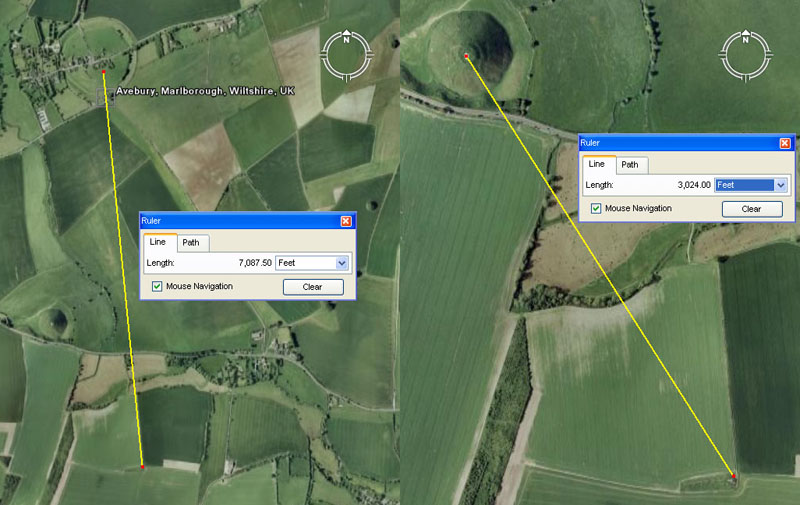
Left: From the obelisk at Avebury Henge a line runs
southwards and touches down on the line of obelisk boulders adjacent to the
doorway into West Kennet Longbarrow. The intended or coded distance for this
length was very definitely 7087.5' (10 X the
design length of Khafre Pyramid). The distance is fully verified by the return
angle back to the obelisk at Avebury Henge, which is
354.375° (354.375 - 3543/8-days
= the lunar year and this value in feet is half the length of Khafre Pyramid).
Right: From that position adjacent to the doorway into
West Kennet Longbarrow a line runs for 3024'
to the centre crown of Silbury Hill. The Great Pyramid @ 756' per side = 3024'
for one circumnavigation of the perimeter. This distance is half of 1-minute
of arc for a world that is 12 X 12 X 12 X 12 X 1.2 Greek miles in circumference
(24883.2-miles). The intended return angle from Silbury Hill to the spot adjacent
to the barrow doorway was 147.65625°
(14721/32nds). This value is lunar and is
taken directly from the design dimensions of the Khafre Pyramid. It will be
remembered that the diagonal face of the Khafre 3,4,5 triangle was 590.625'
(5905/8)
of which 147.65625' equals one quarter of that
length. The sum of 1449/64ths-days
(354.375 - 3543/8 hours)
would be two lunar weeks to a tolerance of under 30 seconds of time.
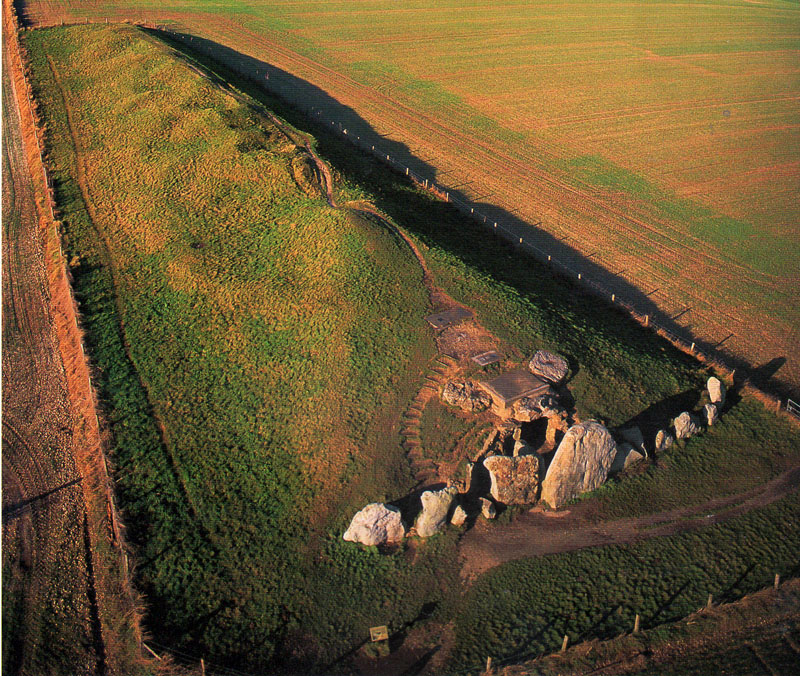
The row or wall of stones in front of the doorway into
West Kennet Long Barrow runs towards Avebury Henge. The giant obelisk of the
henge sat 7087.5' away at an azimuth angle of
354.375° from the stone
row by the doorway. Both in distance and angle the coding is lunar. Alternatively,
the centre of the prominent "V" dip further along the barrow's ridge
path sat at an azimuth angle of 175° from the henge's obelisk (a very
dynamic, ancient navigational and lunar value). From the "V" dip
at West Kennet Longbarrow, due North was the eastern edge of Avebury Henge's
embankment. Photo by Jason Hawkes, Prehistoric Britain from the Air,
by Janet & Colin Bord, 1997.
Isn't it very strange how all of these dimensions were positively
encoded into the English landscape about 500-years or so before the Great
Pyramid was supposed to have been built? ... unless our experts are very much
off the mark concerning the age of the pyramids or who actually built them.
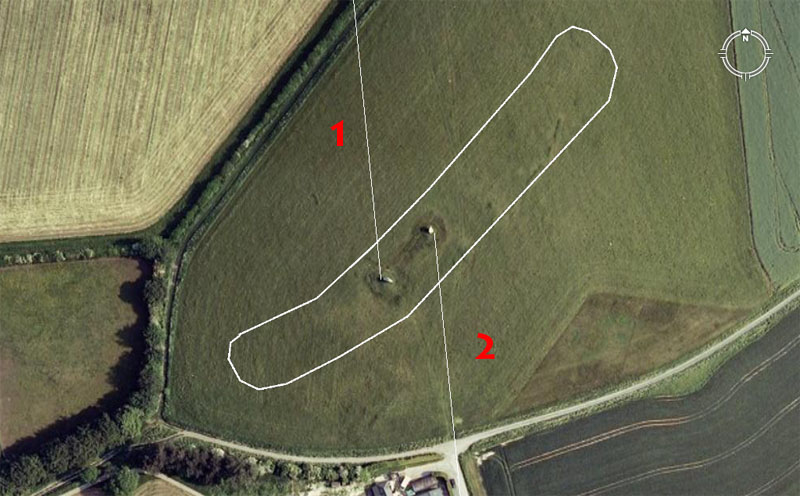
The same "Khafre Pyramid" lunar coding extends
to outer markers from the Beckhampton longstones. These are:
1. A line runs for 7087.5'
northwards to the centre of Windmill Hill at
an azimuth angle of 354.375°.
2 A line runs for 6048'
southwards to the centre of a marker mound and the return angle is, again,
354.375 - 3543/8°.
Under the Great Pyramid's geodetic assignment for the equatorial size of the
Earth, 6048' represented 1-minute of arc. The
Great Pyramid @ 756' per side was 6048' ÷ 8 in side length.
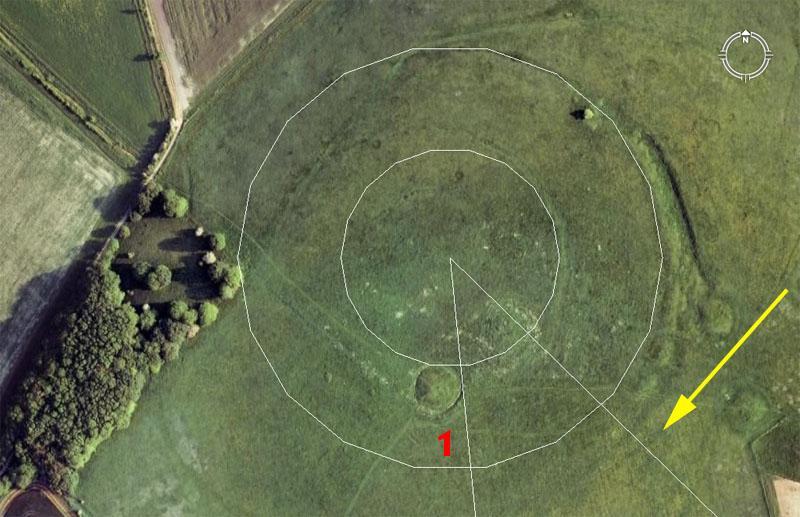
The northwards running line from the Beckhampton
longstone resolves to the centre
of Windmill Hill after brushing the side of an outlying mound. The
yellow arrow shows the line that runs from the centre of windmill Hill to
the obelisk position at Avebury Henge. The angle
from the Henge is 314.16° azimuth (coding
PI X 100). The distance of 7333.3333' - 73331/3
provides a mathematical progression for navigation by the "11" family
of numbers (league, mile, etc.).
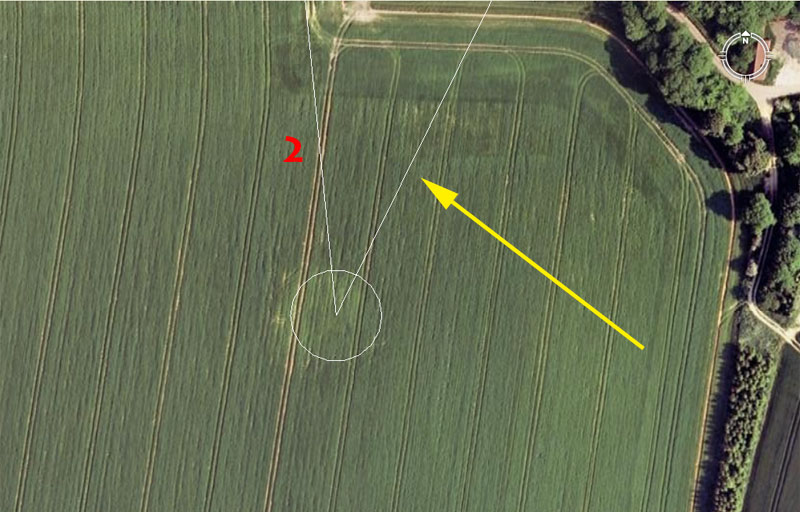
The southern running line from the Beckhampton longstone
extends for 6048' and resolves upon the centre
of a former marker mound which is almost fully flattened and obscured by millenniums
of farming, but still visible. The angle back to the Beckhampton Longstone
is 354.375 - 3543/8°.
This former mound position was considerably clearer after harvest and initial
field regrowth, as seen in an earlier version of Google Earth. The yellow
arrow shows the return line to the obelisk position
at Avebury Henge. The angle to the obelisk is 26.25
- 261/4° (a very important lunar
code or mathematical progression). The distance is 8800', which again homes
in on the "11" series of navigational increments like the mile @
5280'. The distance of 8800' would be 12/3rds
British miles.
FOOTNOTE 2.
The Great Pyramid at 9072-inches of length is 5600 rounded PHI
inches (1.62" - 131/50").
An increment of length that Professor Alexander Thom found recurring at very
weatherworn Stonehenge, which he estimated to be about 32.64-inches was, undoubtedly,
originally intended to be 20 "rounded" PHI
inches or 32.4 - 322/5". Here's how
the Great Pyramid was read in PHI
related increments:
If one uses simple trigonometry to work out the side length
of the full pyramid, including the theoretical, non-existent capstone (In
all recorded history the Great Pyramid was never observed to have a capstone),
the length to the centre apex would be (Adj. ÷ 51.84 Cos.) = 611.7894615
feet.
Alternatively, if one used a PHI
method of Adj. (378 feet) X PHI
(1.6180339) = 611.6168142 feet.
It will be observed that the calculated PHI
length is only about 2 inches less than the length achieved by straight trigonometry.
The ancient astronomer/ mathematicians were coding a PHI
related angle for the Great Pyramid simultaneously to the standard angle of
51.84°. The whole edifice was designed to clearly code PHI
relationships. For example:
Let's consider the Great Pyramid on the basis of the PHI
ratio and the relationship (in Egyptian pyramid acres identified from the
writings of Herodotus) between the 4 faces, compared to the ground area that
the Great Pyramid covers.
The surface area of each face of the theoretical full pyramid, complete with
a (symbolic) pointed capstone, = 611.6168142 feet of side length X 378 feet
(1/2) the base length) = 231191.11558 square
feet.
Because there are 4 faces, their combined square footage amounts
to 924764.6231 square feet. This translates to 32.10988275
Egyptian pyramid acres of 28800 square feet each.
The base area measured 756 feet X 756 feet or 571536 square feet, which equated
to 19.845 Egyptian pyramid acres of 28800 sq.
ft each. A perfect PHI
relationship exists between this (symbolic capstone included) total side acreage
and that of the base: 32.10988275 ÷ 19.845 = 1.6180339 (PHI).
Continue







